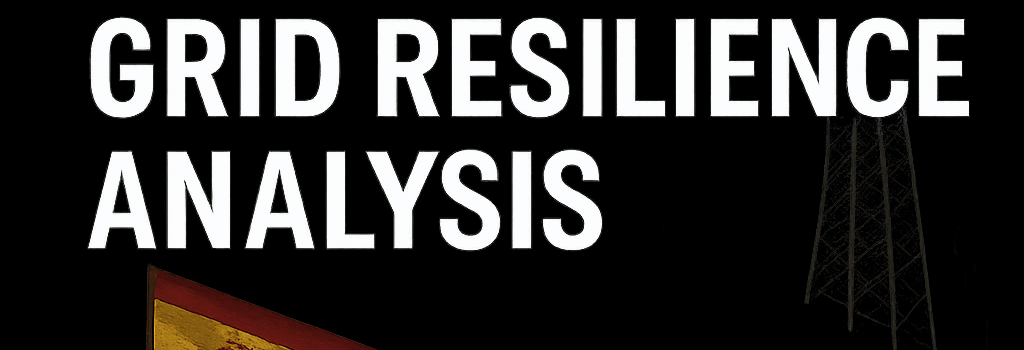Spain’s April Blackout and Grid Resilience Analysis

Summary: An official Spanish government investigation attributes the April Iberian blackout to grid management shortcomings, not renewable energy. Technical missteps in voltage regulation and unexpected generator behavior triggered a self-reinforcing cascade. Latest follow-up measures now focus on enhanced grid services, advanced control systems, and stricter equipment compliance.
Background: Anatomy of the Iberian Blackout
On April 28, 2025, Spain and Portugal experienced a widespread blackout when voltage surges caused multiple generators to trip off the network. Contrary to claims by some critics, the extensive investigation confirms that neither wind farms nor solar parks contributed to the disturbance.
Timeline of Events
- Pre-April 28: Persistent voltage fluctuations due to minor supply-demand mismatches.
- 12:05 UTC: Anomalous frequency oscillation (Δf ≈ ±0.08 Hz) originates from an unidentified “instalación.”
- 12:20 UTC: Voltage regulation response suppresses oscillation but raises bus voltages by ~3 kV.
- 12:35 UTC: Secondary oscillations at 0.1 Hz appear; corrective actions further escalate voltages.
- 12:45 UTC: Ten voltage regulation units on call—lowest daily count in 2025—fail or misrespond.
- 12:50–13:00 UTC: Incremental voltage rise hits 400 kV threshold; generators initiate protective disconnections.
- 13:05 UTC: Loss of synchronism with France at 50 Hz leads to regional blackout.
Key Findings from the Government Report
- Underprovisioned Voltage Support: Only 10 reserve units—far below recommended N-1 contingency levels—were scheduled.
- Equipment Noncompliance: Several generators failed to adhere to ENTSO-E voltage ride-through curves (RVC-REQ-001). Some tripped prematurely below their protective detachment thresholds.
- Managerial Response Effects: Grid operator commands quashed oscillations at the expense of steady‐state voltage control, inadvertently fueling the cascade.
- No Cyber Intrusion: A parallel cybersecurity audit ruled out hacking or malware-induced maloperation.
Technical Deep Dive: Voltage Regulation Systems
Modern grid stability relies on a mix of conventional synchronous generators, static VAR compensators (SVCs), and emerging battery energy storage systems (BESS). In this incident:
- SVC Units: Three of the four SVC installations exhibited control‐loop oscillations. Analysis shows suboptimal tuning of their Power System Stabilizer (PSS) modules.
- BESS Response: Two battery arrays provided rapid frequency response (RFR) within 100 ms, but their voltage regulation mode was disabled pending a firmware upgrade.
- Generator Excitation Controls: Several units lacked the latest IEC 61850–9–2 process bus interoperability, leading to delayed command execution.
Expert Perspectives
“The incident underscores the importance of adhering to stringent ride-through and low-voltage fault‐ride-through specifications. Grid codes must evolve alongside hardware capabilities,” says Dr. María Martínez, Senior Grid Engineer at Red Eléctrica de España.
“Integrating dynamic inertia from renewables via synthetic inertia has made great strides, but this event shows traditional units still play a critical role in voltage regulation,” adds Professor Pierre Dubois of ETH Zurich’s Power Systems Group.
Lessons Learned and Policy Recommendations
- Mandate minimum on-call voltage support units to meet N-1+1 reserve criteria.
- Enforce compliance testing for generator ride-through performance per EN 50549 standards.
- Upgrade SCADA and DERMS platforms with predictive analytics to anticipate oscillatory modes.
- Conduct regular grid code drills simulating multi-location oscillations and islanding scenarios.
Implications for Renewable Integration
Rather than indict renewables, the blackout highlights how hybrid systems—combining conventional and inverter‐based resources—must share grid‐stabilizing duties. As of July 2025, Red Eléctrica has:
- Contracted 300 MW of fast‐frequency response from distributed BESS networks.
- Trialed SiC‐based HVDC links delivering sub‐millisecond voltage support.
- Launched a digital twin project leveraging AI to forecast instability with 99.2% accuracy.
Conclusion
The Iberian blackout was a multifaceted grid management event rather than a failure of renewable technology. Implementing the report’s technical and regulatory recommendations will enhance system resilience, paving the way for deeper decarbonization without compromising reliability.